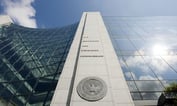The Securities and Exchange Commission’s just-released annual examination report on the nationally recognized statistical rating organizations (NRSROs) showed procedural improvements but also found instances where the rating agencies exhibited compliance shortcomings, notably not adhering to their own ratings criteria.
The SEC staff released two reports Tuesday to the Senate Banking and House Financial Services Committees — the annual report as well as a summary report of its exam findings.
SEC staff investigates compliance with federal securities laws and rules while identifying insufficient or failing conduct, procedures or internal controls and recommends remedial action.
For purposes of the audit, the three large NRSROs are Moody’s Investors Service Inc., S&P Global Ratings and Fitch Ratings Inc.
Seven others, including A.M. Best Ratings Services Inc. and Kroll Bond Rating Agency Inc., are referred to in the report as the smaller rating agencies.
The report doesn’t identify which rating agency didn’t adhere to specified policies although it provides a series of compliance snafus.
For example, the report notes that in two instances, one of the three large NRSROs failed to have information in its complaint log or in other documents regarding allegations made by three employees.
When SEC staff inquired about the allegations, this rating agency failed to initially hand over the relevant documents. The NRSRO did not record or even treat as a complaint, an allegation by an outside party that a rating was withdrawn “for self-serving purposes,” the SEC report stated.









 December 20, 2018 at 06:48 AM
December 20, 2018 at 06:48 AM











